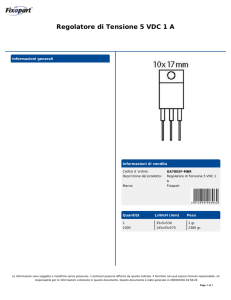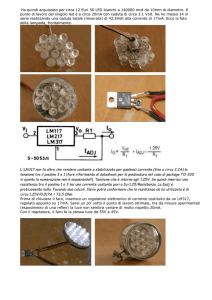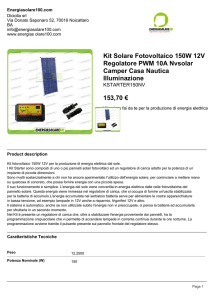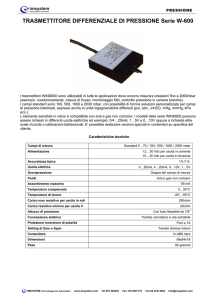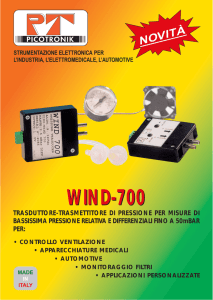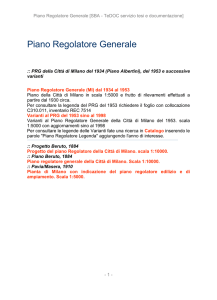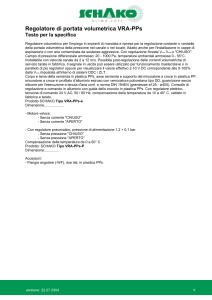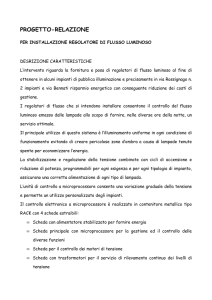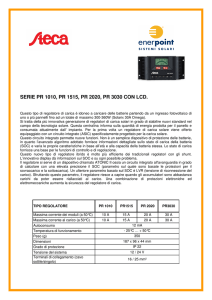VM 201 - ATR Industrie
annuncio pubblicitario
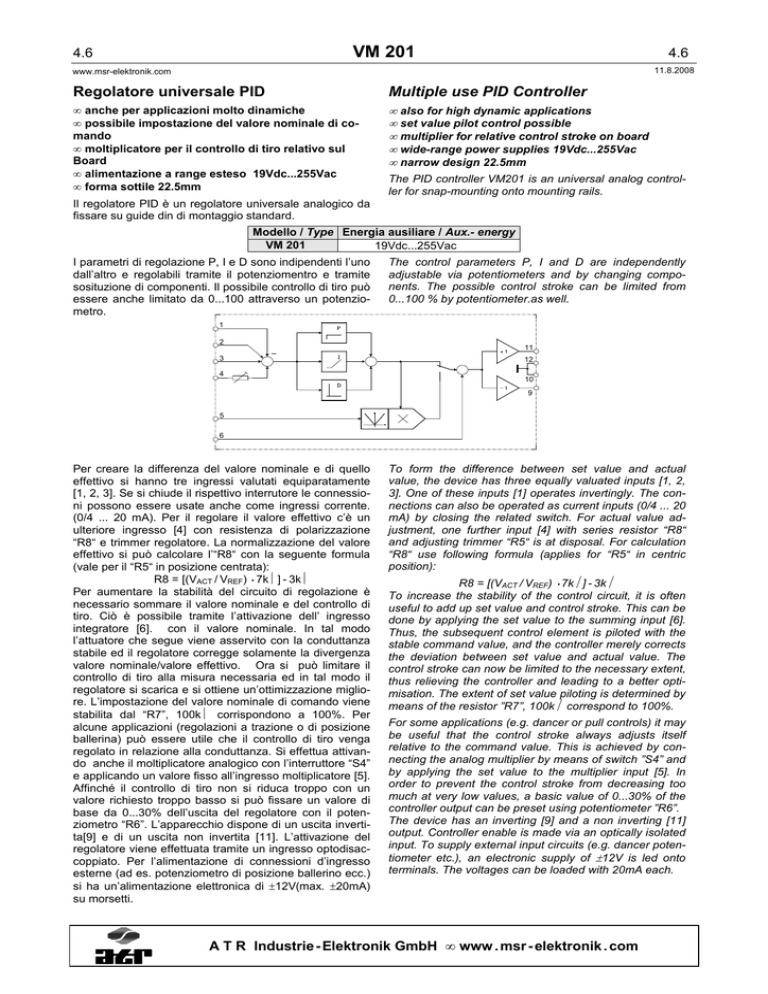
VM 201 4.6 4.6 11.8.2008 www.msr-elektronik.com Regolatore universale PID Multiple use PID Controller • anche per applicazioni molto dinamiche • possibile impostazione del valore nominale di comando • moltiplicatore per il controllo di tiro relativo sul Board • alimentazione a range esteso 19Vdc...255Vac • forma sottile 22.5mm • • • • • also for high dynamic applications set value pilot control possible multiplier for relative control stroke on board wide-range power supplies 19Vdc...255Vac narrow design 22.5mm The PID controller VM201 is an universal analog controller for snap-mounting onto mounting rails. Il regolatore PID è un regolatore universale analogico da fissare su guide din di montaggio standard. Modello / Type Energia ausiliare / Aux.- energy VM 201 19Vdc...255Vac I parametri di regolazione P, I e D sono indipendenti l’uno dall’altro e regolabili tramite il potenziomentro e tramite sosituzione di componenti. Il possibile controllo di tiro può essere anche limitato da 0...100 attraverso un potenziometro. The control parameters P, I and D are independently adjustable via potentiometers and by changing components. The possible control stroke can be limited from 0...100 % by potentiometer.as well. 1 2 3 4 11 12 10 9 5 6 Per creare la differenza del valore nominale e di quello effettivo si hanno tre ingressi valutati equiparatamente [1, 2, 3]. Se si chiude il rispettivo interrutore le connessioni possono essere usate anche come ingressi corrente. (0/4 ... 20 mA). Per il regolare il valore effettivo c’è un ulteriore ingresso [4] con resistenza di polarizzazione “R8“ e trimmer regolatore. La normalizzazione del valore effettivo si può calcolare l’“R8“ con la seguente formula (vale per il “R5“ in posizione centrata): R8 = [(VACT / VREF) ⋅ 7kΩ] - 3kΩ Per aumentare la stabilità del circuito di regolazione è necessario sommare il valore nominale e del controllo di tiro. Ciò è possibile tramite l’attivazione dell’ ingresso integratore [6]. con il valore nominale. In tal modo l’attuatore che segue viene asservito con la conduttanza stabile ed il regolatore corregge solamente la divergenza valore nominale/valore effettivo. Ora si può limitare il controllo di tiro alla misura necessaria ed in tal modo il regolatore si scarica e si ottiene un’ottimizzazione migliore. L’impostazione del valore nominale di comando viene stabilita dal “R7”, 100kΩ corrispondono a 100%. Per alcune applicazioni (regolazioni a trazione o di posizione ballerina) può essere utile che il controllo di tiro venga regolato in relazione alla conduttanza. Si effettua attivando anche il moltiplicatore analogico con l’interruttore “S4” e applicando un valore fisso all’ingresso moltiplicatore [5]. Affinché il controllo di tiro non si riduca troppo con un valore richiesto troppo basso si può fissare un valore di base da 0...30% dell’uscita del regolatore con il potenziometro “R6”. L’apparecchio dispone di un uscita invertita[9] e di un uscita non invertita [11]. L’attivazione del regolatore viene effettuata tramite un ingresso optodisaccoppiato. Per l’alimentazione di connessioni d’ingresso esterne (ad es. potenziometro di posizione ballerino ecc.) si ha un’alimentazione elettronica di ±12V(max. ±20mA) su morsetti. To form the difference between set value and actual value, the device has three equally valuated inputs [1, 2, 3]. One of these inputs [1] operates invertingly. The connections can also be operated as current inputs (0/4 ... 20 mA) by closing the related switch. For actual value adjustment, one further input [4] with series resistor “R8“ and adjusting trimmer “R5“ is at disposal. For calculation “R8“ use following formula (applies for “R5“ in centric position): R8 = [(VACT / VREF) ⋅ 7kΩ] - 3kΩ To increase the stability of the control circuit, it is often useful to add up set value and control stroke. This can be done by applying the set value to the summing input [6]. Thus, the subsequent control element is piloted with the stable command value, and the controller merely corrects the deviation between set value and actual value. The control stroke can now be limited to the necessary extent, thus relieving the controller and leading to a better optimisation. The extent of set value piloting is determined by means of the resistor ”R7”, 100kΩ correspond to 100%. For some applications (e.g. dancer or pull controls) it may be useful that the control stroke always adjusts itself relative to the command value. This is achieved by connecting the analog multiplier by means of switch ”S4” and by applying the set value to the multiplier input [5]. In order to prevent the control stroke from decreasing too much at very low values, a basic value of 0...30% of the controller output can be preset using potentiometer ”R6”. The device has an inverting [9] and a non inverting [11] output. Controller enable is made via an optically isolated input. To supply external input circuits (e.g. dancer potentiometer etc.), an electronic supply of ±12V is led onto terminals. The voltages can be loaded with 20mA each. A T R Industrie - Elektronik GmbH • www . msr - elektronik . com VM 201 4.6 4.6 11.8.2008 www.msr-elektronik.com H1 13 14 S1 1 S2 2 S3 3 4 9 b 5 c a S4 11 6 10 A 12 B 7 19Vdc ... 255Vac 8 +12V –12V A T R Industrie - Elektronik GmbH • www . msr - elektronik . com VM 201 4.6 4.6 11.8.2008 www.msr-elektronik.com Dati tecnici VM 201 Tensione di alimentazione DC [A, B] : 19...255Vdc Tensione di alimentazione AC [A, B] : 24...255V / 48...62Hz Potenza assorbita : 1W...2.5VA Uscita in tensione [7, 8] : ±12V / 2 x 20mA Attivazione del regolatore [13, 14] : 15...30V / 5...12mA Tensione del regolatore d’ingresso[1, 2, 3] : 0...±10V / R IN = 47kΩ Regolatore corrente di ingresso [1, 2, 3] : 0(4)...20mA / Burden = 100Ω Ingresso regolatore [4] : max. ±200V Ingresso integratore [6] : 0...±10V / R IN=100kΩ Ingresso moltiplicatore [5] : 0...±10V / R IN=100kΩ Uscita regolatore [9, 11] : 0...±12V / max. 10mA (max. 50V sovraccarico) (max. 50mA sovraccarico) (max. 50V sovraccarico) (max. 50V sovraccarico) Parametri del regolatore: • Parte P / regolazione precisione • Parte I / regolazione precisione • Parte D / regolazione precisione • Controllo di tiro • regolazione di base del moltiplicatore Errore zero Deriva della temperatura Temperatura ambiente Materiale della custodia Montaggio della custodia Connessioni : resistenza R9 / Pot "P" (destra stop = max. KP) : condensatore C1 / Pot "I" (destra stop = max. TN) : condensatore C2 / Pot "D" (destra stop = max. TV) : Pot "HUB" (0...100%) : pot R6 (destra stop = 30%) : 0.001% : 0.002%/K : 0...50°C : materiale isolante grigio : montaggio per TS15, TS32, TS35 : morsetti a vite 2.5mm² Peso : 130g Technical Data VM 201 Supply voltage DC Supply voltage AC Power consumption [A, B] [A, B] : 19...255Vdc : 24...255V / 48...62Hz : 1W...2.5VA Voltage output [7, 8] : ±12V / 2 x 20mA Controller enable Controller input Voltage Controller input Current Controller input Summing input Multiplier input Controller output [13, 14] [1, 2, 3] [1, 2, 3] [4] [6] [5] [9, 11] : 15...30V / 5...12mA : 0...±10V / R IN = 47kΩ : 0(4)...20mA / Burden = 100Ω : max. ±200V : 0...±10V / R IN=100kΩ : 0...±10V / R IN=100kΩ : 0...±12V / max. 10mA Control parameters: • P-part Coarse / Precision adjustment • I-part Coarse / Precision adjustment • D-part Coarse / Precision adjustment • Control stroke • Basic value setting for Multiplier : Resistor R9 / Pot "P" : Capacitor C1 / Pot "I" : Capacitor C2 / Pot "D" : Pot "HUB" : Pot R6 Zero error Temperature drift : 0.001% : 0.002%/K Ambient temperature Housing material Fastening of housing Connections Weight : 0...50°C : Insulating material grey : Snap-on for TS15, TS32, TS35 : Screw-type terminals 2.5mm² : 130g (max. 50V overload) (max. 50mA overload) (max. 50V overload) (max. 50V overload) (Right stop = max. KP) (Right stop = max. TN) (Right stop = max. TV) (0...100%) (Right stop = 30%) A T R Industrie - Elektronik GmbH • www . msr - elektronik . com
